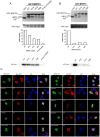Structural and mechanistic insights into regulation of HBO1 histone acetyltransferase activity by BRPF2
- PMID: 28334966
- PMCID: PMC5449618
- DOI: 10.1093/nar/gkx142
Structural and mechanistic insights into regulation of HBO1 histone acetyltransferase activity by BRPF2
Abstract
HBO1, a member of the MYST family of histone acetyltransferases (HATs), is required for global acetylation of histone H3K14 and embryonic development. It functions as a catalytic subunit in multisubunit complexes comprising a BRPF1/2/3 or JADE1/2/3 scaffold protein, and two accessory proteins. BRPF2 has been shown to be important for the HAT activity of HBO1 toward H3K14. Here we demonstrated that BRPF2 can regulate the HAT activity of HBO1 toward free H3 and H4, and nucleosomal H3. Particularly, a short N-terminal region of BRPF2 is sufficient for binding to HBO1 and can potentiate its activity toward H3K14. The crystal structure of the HBO1 MYST domain in complex with this segment of BRPF2 together with the biochemical and cell biological data revealed the key residues responsible for the HBO1-BRPF2 interaction. Our structural and functional data together indicate that the N-terminal region of BRPF2 plays an important role in the binding of HBO1 and a minor role in the binding of nucleosomes, which provide new mechanistic insights into the regulation of the HAT activity of HBO1 by BRPF2.
© The Author(s) 2017. Published by Oxford University Press on behalf of Nucleic Acids Research.
Figures





Similar articles
-
The scaffolding protein JADE1 physically links the acetyltransferase subunit HBO1 with its histone H3-H4 substrate.J Biol Chem. 2018 Mar 23;293(12):4498-4509. doi: 10.1074/jbc.RA117.000677. Epub 2018 Jan 30. J Biol Chem. 2018. PMID: 29382722 Free PMC article.
-
Molecular Insights into the Recognition of Acetylated Histone Modifications by the BRPF2 Bromodomain.Biochemistry. 2022 Sep 6;61(17):1774-1789. doi: 10.1021/acs.biochem.2c00297. Epub 2022 Aug 17. Biochemistry. 2022. PMID: 35976792
-
Exchange of associated factors directs a switch in HBO1 acetyltransferase histone tail specificity.Genes Dev. 2013 Sep 15;27(18):2009-24. doi: 10.1101/gad.223396.113. Genes Dev. 2013. PMID: 24065767 Free PMC article.
-
Deciphering structure, function and mechanism of lysine acetyltransferase HBO1 in protein acetylation, transcription regulation, DNA replication and its oncogenic properties in cancer.Cell Mol Life Sci. 2020 Feb;77(4):637-649. doi: 10.1007/s00018-019-03296-x. Epub 2019 Sep 18. Cell Mol Life Sci. 2020. PMID: 31535175 Free PMC article. Review.
-
Biological function and histone recognition of family IV bromodomain-containing proteins.J Cell Physiol. 2018 Mar;233(3):1877-1886. doi: 10.1002/jcp.26010. Epub 2017 Jun 13. J Cell Physiol. 2018. PMID: 28500727 Free PMC article. Review.
Cited by
-
HBO1 catalyzes lysine benzoylation in mammalian cells.iScience. 2022 Oct 26;25(11):105443. doi: 10.1016/j.isci.2022.105443. eCollection 2022 Nov 18. iScience. 2022. PMID: 36388951 Free PMC article.
-
The scaffolding protein JADE1 physically links the acetyltransferase subunit HBO1 with its histone H3-H4 substrate.J Biol Chem. 2018 Mar 23;293(12):4498-4509. doi: 10.1074/jbc.RA117.000677. Epub 2018 Jan 30. J Biol Chem. 2018. PMID: 29382722 Free PMC article.
-
The Protective Effect of HBO1 on Cigarette Smoke Extract-Induced Apoptosis in Airway Epithelial Cells.Int J Chron Obstruct Pulmon Dis. 2020 Jan 6;15:15-24. doi: 10.2147/COPD.S234634. eCollection 2020. Int J Chron Obstruct Pulmon Dis. 2020. PMID: 32021140 Free PMC article.
-
Multifunctional acyltransferase HBO1: a key regulatory factor for cellular functions.Cell Mol Biol Lett. 2024 Nov 14;29(1):141. doi: 10.1186/s11658-024-00661-y. Cell Mol Biol Lett. 2024. PMID: 39543485 Free PMC article. Review.
-
A narrative review of epigenetic marker in H3K27ac and its emerging potential as a therapeutic target in cancer.Epigenomics. 2025 Mar;17(4):263-279. doi: 10.1080/17501911.2025.2460900. Epub 2025 Feb 21. Epigenomics. 2025. PMID: 39981972 Review.
References
MeSH terms
Substances
LinkOut - more resources
Full Text Sources
Other Literature Sources
Molecular Biology Databases

